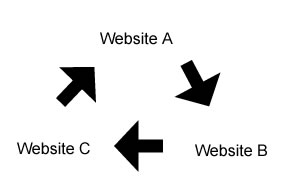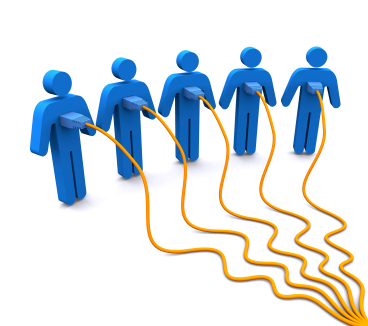 Reciprocal link
Reciprocal link
A reciprocal link is a mutual link between two objects, commonly between two websites to ensure mutual traffic. Example: Alice and Bob have websites. If Bob’s website links to Alice’s website, and Alice’s website links to Bob’s website, the websites are reciprocally linked. Website owners often submit their sites to reciprocal link exchange directories, in order to achieve higher rankings in the search engines. Reciprocal linking between websites is an important part of the search engine optimization process because Google uses link popularity algorithms to rank websites for relevancy.
 Three way linking
Three way linking
Three way linking (site1 – site2 – site3 – site1) is a special type of reciprocal linking. The attempt of this link building method is to create more “natural” links in the eyes of search engines. The value of links by three-way linking can then be better than normal reciprocal links, which are usually done between two domains.
Automated linking
In order to take advantage of the need for inbound links to rank well in the search engines, a number of automatic link exchange services have been launched. Members of these schemes will typically agree to have several links added to all their web pages in return for getting similar links back from other sites.
Link exchange
An alternative to the automated linking above is a link exchange forum, in which members will advertise the sites that they want to get links to, and will in turn offer reciprocal or three way links back to the sites that link to them. The links generated through such services are subject to editorial review.
One-way linking
One-way link is a term used among webmasters for link building methods. It is a hyperlink that points to a website without any reciprocal link; thus the link goes “one-way” in direction. It is suspected by many industry consultants that this type of link would be considered more natural in the eyes of search engines. One-way links are also called Incoming Links or Inbound Links.
An effective way to build this type of one-way linking is by distributing articles through content sites and article directories. These articles generally contain an About The Author box that contains a one-way link back to the author’s URL. When publishers use these articles, those one-way links help authors increase their page rank.
 Multi-way linking
Multi-way linking
Multi-way linking is a technique used for website promotion whereby websites may create similar one-way links that each involves 3 or more partner sites. This provides each website with a one-way non-reciprocal link. This technique has evolved from reciprocal linking. According to Google and Yahoo, the latest search algorithms have evolved to hold less favor towards websites that contain a high percentage of reciprocated links, and a higher favor towards websites that maintain a high level of incoming non-reciprocated (one-way) links.
The term multi-way simply refers to the fact that the link exchange is between 3 or more websites, however each link is singular by only pointing to one other website. Other means of linking that may increase your web presence may also include other indirect methods such as loading images, videos, content or RSS feeds from a third partners website.

